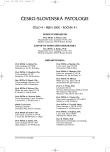-
Medical journals
- Career
Pulmonary Veins and Atrial Fibrillation: A Pathological Study of 100 Hearts
Authors: I. Šteiner 1; P. Hájková 1; J. Kvasnička 2; I. Kholová 1,3
Authors‘ workplace: Fingerlandův ústav patologie LF UK a FN, Hradec Králové 1; I. interní klinika LF UK a FN, Hradec Králové 2; Department of Molecular Medicine, A. I. Virtanen Institute for Molecular Sciences University of Kuopio, Finsko 3
Published in: Čes.-slov. Patol., 41, 2005, No. 4, p. 124-131
Category: Original Article
Overview
Pathogenesis of atrial fibrillation (AF), the most common sustained heart arrhythmia, is not yet fully elucidated. Recent electrophysiological studies have shown that in most patients with AF the arrhythmia is triggered by ectopic beats originating from extensions of left atrial myocardium over the pulmonary veins (PVs), so called myocardial sleeves (MSPV).
A total of 100 hearts (393 PVs) obtained at autopsy were prospectively studied – 50 from patients with chronic AF (average age 76.9 ± 7.3 yrs.) and a control group of 50 with a sinus rhythm (aver. age 71.7 ± 9.5 yrs.). This is a largest study published on this topic so far. It appeared that MSPV frequently harbour pathological lesions, particularly senile atrial amyloid, and scarring. These two pathological changes were evaluated semiquantitatively on a grade 0–3 basis in individual PVs, comparing the results in the AF vs. the control group.
Amyloidosis of MSPV was found in 68 % of all hearts and in 55 % of all sleeves. The deposits were most marked in the right superior PV. Amyloidosis was more frequent and more severe in MSPV of patients with AF (58.5 %; average grade 0.89) than of those without AF (51.7 %; aver. grade 0.76); the differences, however, lack statistical significance.
Scarring of MSPV was present in all 349 sleeves, more markedly in the left inferior, left superior, and right superior PVs. It was significantly more severe in patients with AF compared to those without the arrhythmia. By an injection metod, we have shown that MSPV are supplied by coronary arteries. However, the degree of scarring of the sleeves did not correlate with the degree of coronary atherosclerosis. We suggest that genesis of the scarring is not postnecrotic but degenerative, due to diffuse hypoxia of the sleeve myocardium.
To conclude, amyloidosis and particularly scarring of MSPV appear generally in the elderly population as an arrhythmogenic substrate for AF.Key words:
atrial fibrillation – pathogenesis – pulmonary veins – myocardial sleeves of pulmonary veins – senile heart amyloid
Labels
Anatomical pathology Forensic medical examiner Toxicology
Article was published inCzecho-Slovak Pathology

2005 Issue 4-
All articles in this issue
- Gastrointestinal Stromal Tumor (GIST) with Glandular Component. A Report of an Unusual Tumor Resembling Adenosarcoma
- Adenoid Basal Epithelioma of the Uterine Cervix in 21-Year-Old Patient. Report of a Case with Histologic and Immunohistochemical Study
- BK-Virus Nephropathy and Simultaneous C4d Positive Staining in Renal Allografts
- Pulmonary Veins and Atrial Fibrillation: A Pathological Study of 100 Hearts
- Desmin-Positive and alpha-Smooth Muscle Actin Positive Chondrocytes in Human Defective Articular Cartilage-Preliminary Report
- Autoimmune Gastritis. A Clinicopathologic Study of 25 Cases
- The Role of Intermedial Filament Nestin in Malignant Melanoma Progression
- Melanoma Simulating Malignant Soft Tissue Tumour
- Czecho-Slovak Pathology
- Journal archive
- Current issue
- Online only
- About the journal
Most read in this issue- Autoimmune Gastritis. A Clinicopathologic Study of 25 Cases
- Melanoma Simulating Malignant Soft Tissue Tumour
- Pulmonary Veins and Atrial Fibrillation: A Pathological Study of 100 Hearts
- Gastrointestinal Stromal Tumor (GIST) with Glandular Component. A Report of an Unusual Tumor Resembling Adenosarcoma
Login#ADS_BOTTOM_SCRIPTS#Forgotten passwordEnter the email address that you registered with. We will send you instructions on how to set a new password.
- Career

